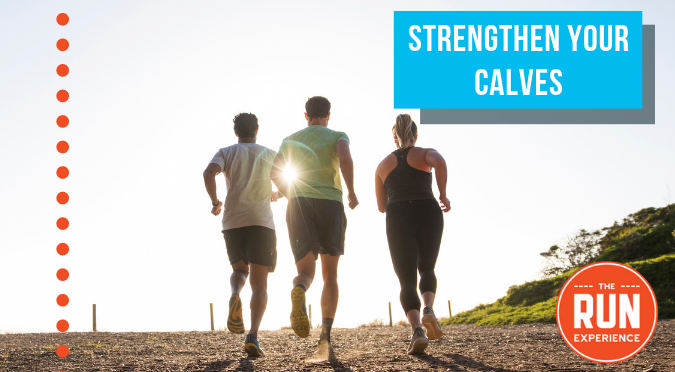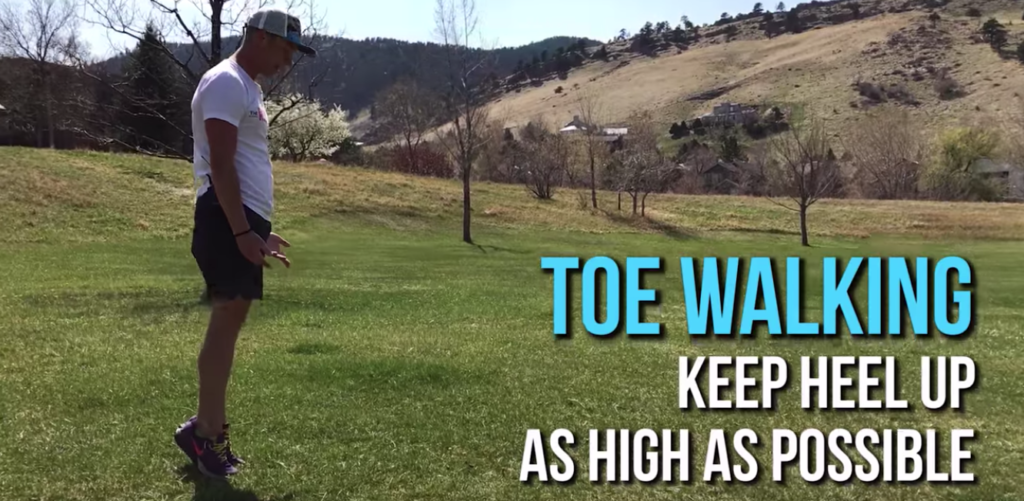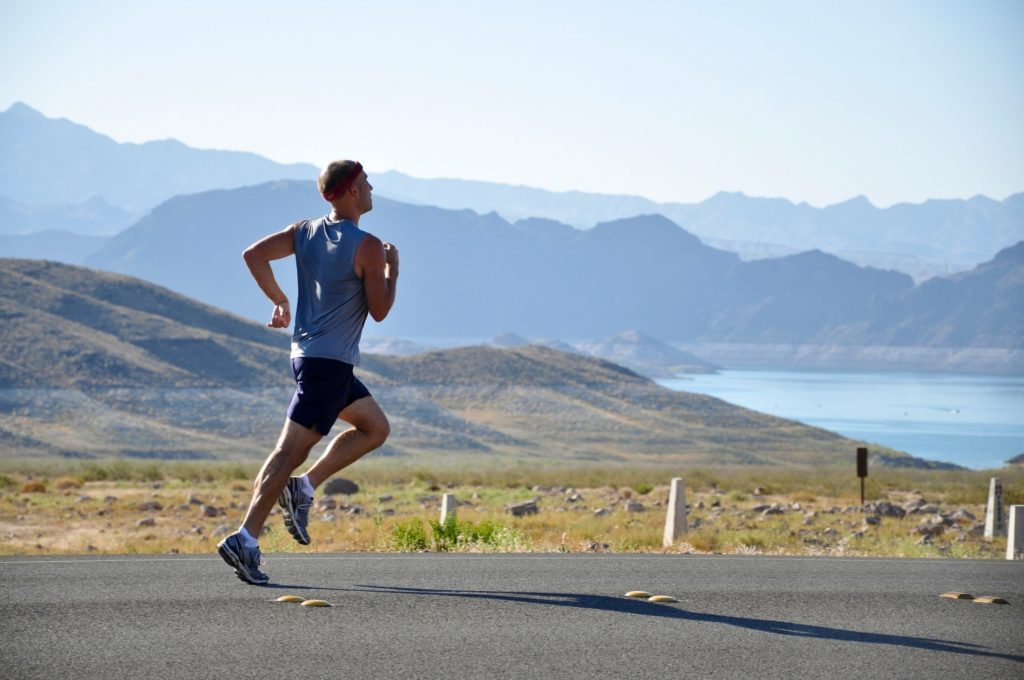Runner's Calves: 7+ Best Calf-Strengthening Exercises for Runners
Start these calf-strengthening exercises to keep your calves healthy and happy. Build lower leg muscles with these 7 calf exercises for runners!

Runner’s calves, am I right? Strengthening your calves is a byproduct of running, but it’s also something you’ll need to focus on with intentional exercises and workouts. Whether you need calf workouts at home or the best calf-strengthening exercises, we’ve got you covered.
Below, we’ll walk you through everything you need to know about training and strengthening your calves for long-distance and short-distance running.
Calf Soreness from Running Is Real
If you’ve been a runner for long at all, you’re no stranger to experiencing sore calves at the end of a long, intense run. Your calf and quad muscles receive the brunt of the impact with every stride, and that’s why calf exercises for runners are so important for keeping your calves healthy. This is especially true if you tend to run on the forefront of your feet–also known as a “toe-runner.”
When I ran cross country in college, I earned the nickname of “Prancer.” No matter how much I tried to correct my form, I always ended up running up on my toes. I adapted over time–but it also put a lot of stress on my calves. I relied heavily on ice baths, as well as these tried-and-true calf-strengthening exercises to keep my calves healthy.
Does Running Build Calves?
Absolutely, running does build your calves—but that doesn’t mean you can skip calf-strengthening exercises and workouts from your weekly routine. While running inherently works your calf muscles, it does so in a different way compared to targeted strength training.
When you run, you subject your calves to low-weight, high-repetition stress. This kind of stress conditions your muscles, enhancing their endurance and ability to perform over long distances. However, for comprehensive muscle development and improved performance, you need to incorporate high-weight, low-repetition stress through specific calf-strengthening exercises. Here’s why:
The Science Behind Running and Calf Development
When you run, each stride you take involves a series of muscle contractions. Your calf muscles, primarily the gastrocnemius and soleus, play a critical role in propelling you forward. They work tirelessly to manage the impact of your foot striking the ground and to push off for the next step. This repetitive action indeed builds strength and endurance in your calves.
However, because running primarily involves lower resistance over a prolonged period, it tends to build muscular endurance rather than maximal strength. This is where specific calf-strengthening exercises come into play.
Benefits of Calf-Strengthening Exercises
Enhanced Muscle Strength:
- High-weight, low-repetition exercises, like weighted calf raises or toe walking with dumbbells, focus on building muscle strength. This helps in developing more powerful calves that can contribute to a stronger push-off with each stride.
Improved Running Form:
- Stronger calves support better running mechanics. They help stabilize your ankles and lower legs, reducing the risk of overpronation or supination, which can lead to injuries. Improved form means you run more efficiently, conserving energy and potentially improving your speed.
Injury Prevention:
- Running can sometimes lead to overuse injuries, particularly in the calves, Achilles tendon, and shins. Calf-strengthening exercises target these areas, making them more resilient to the repetitive stress of running. This can help prevent common running injuries like shin splints, Achilles tendonitis, and calf strains.
Balanced Muscle Development:
- While running predominantly works on endurance, strength training focuses on building muscle mass and strength. This combination ensures balanced development of the muscles, contributing to overall leg strength and stability.
Better Performance:
- Stronger calves can improve your running economy. With each stride, you’ll be able to exert more force with less effort, making your runs feel easier and allowing you to maintain higher speeds for longer periods.
While running will certainly build and condition your calves, integrating dedicated calf-strengthening exercises into your routine is crucial for achieving maximal strength, improved performance, and injury prevention. By balancing endurance training with strength exercises, you can ensure your calves—and your entire lower body—are prepared to handle the demands of running, whether you’re hitting the trails, tackling a marathon, or sprinting to a new personal record.
Why Calf-Strengthening Exercises Are Critical
Strengthing your calves isn’t just about preventing injury to your calves. It’s about protecting your lower legs as a whole. For example, if your calves are too weak, it puts stress on your Achilles tendon and shins. No runner likes dealing with a painful, squeaky Achilles tendon or going through the agony of shin splints.
Want to know more about how to keep your calves in tip-top shape from the coaches at TRE? Check out the first video of Coach Kirk’s three-part series on calf health!

Include these calf exercises into your training routine two to three times per week to improve your form and help prevent injuries by building muscle in your lower body. You can put them into the middle of your run or tack them on at the end while your muscles are warm.
The difference between good calf exercises and great calf exercises is the time and attention you put into them. Don’t just cruise through these so you can rush off to a shower and your post-run smoothie. Be diligent and intentional—take your time.
Good calf workouts aren’t an afterthought—they’re a priority.
It doesn’t have to take long–you just need 5-10 minutes each time. Your calves, shins, and Achilles will thank you for it!
7+ Best Calf Exercises for Runners
1. Best Dynamic Calf Exercise: Jumping Rope
Let’s start with the basics! An exercise as simple as jumping rope not only strengthens your calves, it amps up your cardiovascular ability–which as runners is what we want, right? You don’t have to use a jump rope to do this exercise, but we argue it’s more fun to see if you can set a new jump rope record without tripping!
It can also serve as a great pre-run warm-up. Jump in place on the balls of your feet for 30-60 seconds three times. Repeat for a total for three sets.
Tip: Be sure to land on your toes rather than flat-footed. Landing on your toes is what makes this a great calf exercise–you strengthen those muscles with every jump.
2. Best Static Calf Exercise: Simple Calf Raises
Stand on the edge of a step or sturdy box. Raise your left foot, putting your body weight onto your right foot. Balance on the ball of your right foot.
Next, lift your right heel and pause there for a few moments. Lower your heel and repeat. Alternate feet every 10-15 reps, completing a total of three sets for power up those calves!
Tip: You can also hold dumbbells at your sides to amplify this strength-training exercise.
3. Best Calf Exercise With Dumbbells: Toe Walking
If you have them, grab some dumbbells and hold them at your sides–but this exercise works fine without weights, too.

Lift up your feet and walk forward on your toes for about one minute to 90 seconds. Do three to five sets for stronger calves–particularly the soleus muscle in your calf that’s responsible for plantar flexion–helping you to power off when you run. Remember, don’t let your heels touch the ground–keep them as high as you can!
4. Best Bodyweight Calf Exercise: Ankle Mobilizing Knee Pushes
Assume a starting position in front of a three to four-inch mat or block and put your toes on it so they are elevated past your heels. Bend your right knee and push it forward until you feel that familiar stretch in the back of your calf.
Repeat with your left leg. Aim for three sets of 10-15 reps on each leg.
5. Jumping Half Chair Squats
Stand with your feet shoulder-width apart, flat on the floor. Focusing your energy on your lower legs, jump using only your calves.
We aren’t going for a killer, sky-high jump here–if you’re only using your calves, you won’t get that high. On the way down, absorb the power of your jump by dropping into a half squat and landing quietly.
Complete three sets of eight for toned, healthy calf muscles ready to take on any hill workout. Plus, you’re weaving in a bit of cardio with this exercise!
6. Best Calf Workout at Home: Standing Double-Leg Calf Raises
This exercise might be the most classic move for building strong calves at home. Like a lot of strength training practices for runners, it leverages the power of your body weight.
Stand with your feet hip-width apart–being near a wall can help for balance. Align your ankles, knees, and hips to shield your joints. Press down on the balls of your feet and lift your body up while keeping your core muscles firmly engaged.
Hold for three to five seconds, then come on back down. Do three sets of eight.
7. Best Calf Exercise With Barbell: Weighted Calf Raise
Start by doing this as a double-leg calf raise. Once you’re comfortable with that, advance to single-leg weighted calf raises.
You’ll perform this exercise much the same way as the classic calf raise and double-calf raise. The only difference is you’re going to be adding some more resistance to the calf exercise.
The easiest way to do this is with a barbell and a squat rack.
Get into the squat position with a barbell across the back of your shoulders. However, instead of squatting down, you’re going to simply perform a toe raise.
A weighted exercise like this helps you measure your progress by the number of plates you put on the bar. This helps you progress and grow muscle faster than cranking out 50 to 100+ calf raises.
Can You Train Calves every day?
Yes, you can train calves every day—but just because you can doesn’t mean you should.
Remember, performance gains don’t happen in the gym or on the trail. They happen during the recovery phase. If your body is quick to adapt and soak in the gains, then you can continue to train calves as often as you’d like.
However, if your calves remain sore and tired, you have to take time off to let them rest, recover, and grow stronger. This isn’t a no-pain, no-gain thing. If your calves are in constant pain, you’re not making any strength gains. You’re just shortcutting to a self-induced injury.
Best Calf Workouts at Home
Strengthening your calves doesn’t require a gym membership or fancy equipment. With a few simple exercises, you can effectively build strong, resilient calf muscles right in the comfort of your home. Here are some of the best calf workouts you can do at home:
1. Standing Double-Leg Calf Raises
Instructions:
- Stand with your feet hip-width apart, near a wall or chair for balance if needed.
- Press down on the balls of your feet and lift your body up, keeping your core engaged.
- Hold the raised position for three to five seconds, then slowly lower your heels back to the ground.
- Repeat for three sets of 15-20 reps.
Tip: To increase the difficulty, try holding a dumbbell in each hand or wearing a weighted vest.
2. Single-Leg Calf Raises
Instructions:
- Stand on one foot near a wall or chair for support.
- Press down on the ball of your foot and lift your body up, keeping your core tight and your other foot slightly off the ground.
- Hold the raised position for a few seconds, then slowly lower your heel back to the ground.
- Repeat for three sets of 10-15 reps on each leg.
Tip: To further challenge yourself, perform this exercise on the edge of a step to increase the range of motion.
3. Toe Walking
Instructions:
- Stand with your feet hip-width apart and lift your heels off the ground, balancing on the balls of your feet.
- Walk forward on your toes for 60-90 seconds, keeping your heels elevated the entire time.
- Rest for 30 seconds and repeat for three to five sets.
Tip: Hold a pair of dumbbells at your sides to add resistance and increase the intensity of the exercise.
4. Seated Calf Raises
Instructions:
- Sit on a chair with your feet flat on the ground.
- Place a weight (like a heavy book or a dumbbell) on your thighs, just above your knees.
- Lift your heels off the ground, pressing down on the balls of your feet.
- Hold the raised position for a few seconds, then slowly lower your heels back to the ground.
- Repeat for three sets of 15-20 reps.
Tip: Use a resistance band around the balls of your feet to add extra resistance and challenge your muscles further.
5. Jumping Rope
Instructions:
- Stand with your feet together and hold the jump rope handles in each hand.
- Jump with both feet, landing on the balls of your feet and keeping your jumps low and controlled.
- Jump continuously for 30-60 seconds, then rest for 30 seconds.
- Repeat for three to five sets.
Tip: Focus on maintaining a quick, consistent pace to engage your calf muscles effectively.
6. Ankle Mobilizing Knee Pushes
Instructions:
- Stand facing a wall with one foot slightly behind the other.
- Place your toes of the back foot on a small step or block.
- Bend your front knee and push it forward until you feel a stretch in your back calf.
- Hold the stretch for a few seconds, then return to the starting position.
- Repeat for three sets of 10-15 reps on each leg.
Tip: This exercise not only strengthens your calves but also improves ankle mobility, which is crucial for running efficiency.
7. Jumping Half Chair Squats
Instructions:
- Stand with your feet shoulder-width apart, flat on the floor.
- Focus your energy on your lower legs and jump using only your calves.
- On the way down, absorb the power of your jump by dropping into a half squat and landing quietly.
- Complete three sets of eight reps.
Tip: Keep the jumps small and controlled, focusing on calf engagement rather than height.
Don’t Underestimate the Importance of Injury Prevention
It’s common for runners to experience sore calves–these muscles power our runs and give us the strength to tackle steep hills and fire off speedy kicks at the end of a race. So, we have to take care of them!

There’s nothing that can deter even the most disciplined training plan and running goals more than an injury that could have been prevented. Resolving those injuries involves more than drinking enough water and light stretching.
Listen to your body and invest the time into proper stretching, ice baths, and strength training activities. It might not be the most fun part of your training routine–but it’s worth it! Your entire body and personal records will thrive as a result!
Don’t wait for an injury to start doing these calf exercises for runners. Make calf-strengthening a priority—not an afterthought.
A happy runner is a healthy runner with strong muscles, enjoying pain-free runs. Get started by downloading our FREE injury prevention video series today!
